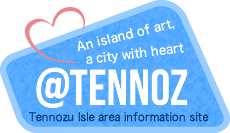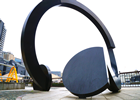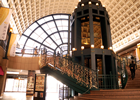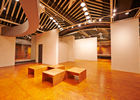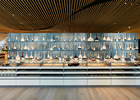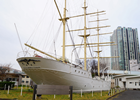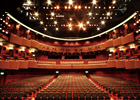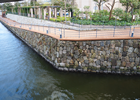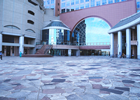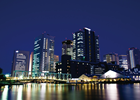Art
 Art exhibits (Tennoz Central Tower, 1st Floor, Art Hall)
Art exhibits (Tennoz Central Tower, 1st Floor, Art Hall)
The works have been mainly focused on craftworks but the genre ranges widely from craftwork to sculpture, Western painting, Japanese painting, calligraphy, flower arrangement, etc. The exhibitions are not only by young artists but quite a few are by famous artists.
There is no admission, so you can see the latest and greatest works by talented artists.
 Object 1: “2005 Sasayaki” (Tennoz Isle Central Tower, Isle Court)
Object 1: “2005 Sasayaki” (Tennoz Isle Central Tower, Isle Court)
This piece is by sculptor Hideo Okuma and was installed in 2005. [profile] Hideo Okuma 1955: Born in Sendai 1980: Department of Crafts, Tokyo University of the Arts 1982: MFA, Tokyo University of the Arts (graduation work was purchased by a patron)
 Object 2: Work 2012 -- Toyoko Inn Shinagawa, Nanko Gate Tennoz
Object 2: Work 2012 -- Toyoko Inn Shinagawa, Nanko Gate Tennoz
This piece was created by contemporary sculptor Kimiyo Mishima, and installed in 2012 at the bus stop space in front of the Tokyo Inn Shinagawa Konan Gate Tennoz area. [profile] Kimiyo Mishima 1932: Born in Osaka Prefecture 1951: Ogyomachi Municipal High School 1986-87: Received a grant from the Rockefeller Foundation (ACC) to study abroad in New York City Official web site: http://www.mishimakimiyo.com/
 Object 3: “Tap” -- Konan Park
Object 3: “Tap” -- Konan Park
This work by sculptor Makoto Ito was installed at Konan Park in 1995. [profile] Makoto Ito 1955: Born in Aichi Prefecture 1981: Department of Sculpture, Musashino Art University 1983: MFA, Faculty of Modeling Arts, Musashino Art University 1993: Through a grant from the Asian Cultural Council, resided in New York and took part in the Triangle Artists’ Workshop 1996-97: Resided in Ireland as a researcher with the Japanese Agency for Cultural Affairs Currently a researcher at the Faculty of Modeling Arts, Department of Sculpture, Musashino Arts University
 Object 4: untitled (circular form) -- installed at Tennoz Isle Park #9
Object 4: untitled (circular form) -- installed at Tennoz Isle Park #9
This work can be found at Tennoz Isle Park #9. This monument suggests the image of clouds and is installed on elevated ground at the center of the park.
 Galleries (Sea Fort Square)
Galleries (Sea Fort Square)
The center of the shopping zone has an open atrium that makes for a beautiful architectural landmark. c This site has been used in countless television programs, films, and commercials. They also illuminate the area with beautiful lighting in winter. Click here for details on Sea Fort Square’s buildings
 Meguro River Gates (Installed at Tennoz Canal and Meguro River)
Meguro River Gates (Installed at Tennoz Canal and Meguro River)
In 2007, the Shinagawa Ura/Tennoz District Renaissance Project selected this piece as part of a public call for artwork. The gates feature the motif of a whale, inspired by the story of a whale that wandered into the Shinagawa waters in 1798. The piece is appropriately called, “Shinagawa Whale.” Look closely and you will see that the waves actually spell out “しながわ(Shinagawa)” in Japanese.
 Street furniture (Midori Plaza)
Street furniture (Midori Plaza)
The design was overseen by architectural firm Gensler. Gensler was responsible for the design of the atrium and entrance hall at Sky Tower Tennoz, the signage, and the furniture. The furniture in the plaza was developed by Magis. This furniture is designed by a range of designers. Though installed outdoors, this furniture can also be used indoors. Not only do these chairs offer great design, but they are extremely comfortable to sit in. Enjoy a break from your trip among the lovely furniture.
 T-Art gallery (Terratoria)
T-Art gallery (Terratoria)
Here you will find exhibits on a range of themes like art, culture, and business. It is used as a place where people congregate. Click here for the official web site.
 PIGMENT (TERRADA Harbor One Building)
PIGMENT (TERRADA Harbor One Building)
This “laboratory” for traditional art materials showcases rare art supplies native to Japan, as well as those from neighboring Asian countries. The back wall is lined with over 4500 colors of pigments, and they are beautiful in the vivid colors they give off. Click here for the official web site.
Culture · History
 Unyo-Maru boat (Tokyo University of Marine Science and Technology)
Unyo-Maru boat (Tokyo University of Marine Science and Technology)
From May 1909 to August 1929, this ship made 33 circuits of the seas and carried out whale-fishing, fish surveys, training for marine students, and more, contributing to the development of fishing technologies and tools. They also succeeded in developing a technology for canning crab aboard the ship, serving as a frontrunner in the later development of large-scale crab vessels. In 1962, it was moved to the Shinagawa campus of the Tokyo University of Marine Science and Technology. On December 11, 1998, it was inscribed as a national tangible cultural property.
 The Galaxy Theatre (Sea Fort Square)
The Galaxy Theatre (Sea Fort Square)
Boasting 746 seats, this is a horseshoe-shaped theater with three levels. This design makes for the ideal performance space, with the seats and stage separated at most by 20 meters. A range of theater, musicals, music, dance, and other shows are put on. Click here for details
 Sea Fort Square: remains of fourth fortress
Sea Fort Square: remains of fourth fortress
In 1853, Commodore Perry arrived in Japan and ordered the shogunate government to open its doors to the rest of the world. Feeling a sense of urgency, the shogunate had drawn up plans to install eleven fortresses in the seas around Shinagawa. The fourth fortress can be found here. After seventy percent of the fortress was complete, the project was scrapped, and was then adopted as a shipbuilding yard. By the time Commodore Perry arrived, fortresses were complete in several locations, with batteries ready to fire. This caused Perry to draw back as far as Yokohama before going ashore. Remnants of the fortresses of the day can be seen throughout Sea Fort Square, and the dike along today’s boardwalk is a reconstruction of the original stone walls.
 Center Court (Sea Fort Square)
Center Court (Sea Fort Square)
Sea Fort Square was completed in the early 1990s during Japan’s economic boom times, and it has continued to be used for the set of various television programs and commercials. As you proceed from Center Court and along the canals, you will see the Lady Crystal moored at the pier. If you are lucky, you may even see the rare “Doctor Yellow,” a special train used for maintenance purposes. This is a must-visit spot if you like vehicles.
 Warehouse district (BOND Street)
Warehouse district (BOND Street)
In 1950s, Tennoz Isle came to be used as a warehousing district. It was an empty space still devoid of office buildings and residences. Following Japan’s economic boom times, development in the area grew widespread. Warehouse TERRADA had installed warehouses throughout Tennoz Isle since its founding and had long been implicated in the growth of the city. After Japan’s economic bubble declined, TERRADA’s first warehouse was repurposed as T.Y.HARBOR Brewery in a bid to regrow the area. Today, the shops along the waterfront have become recreational destinations for visitors, and the exteriors of the warehouses are considered photogenic. Click here for details onBOND Street

